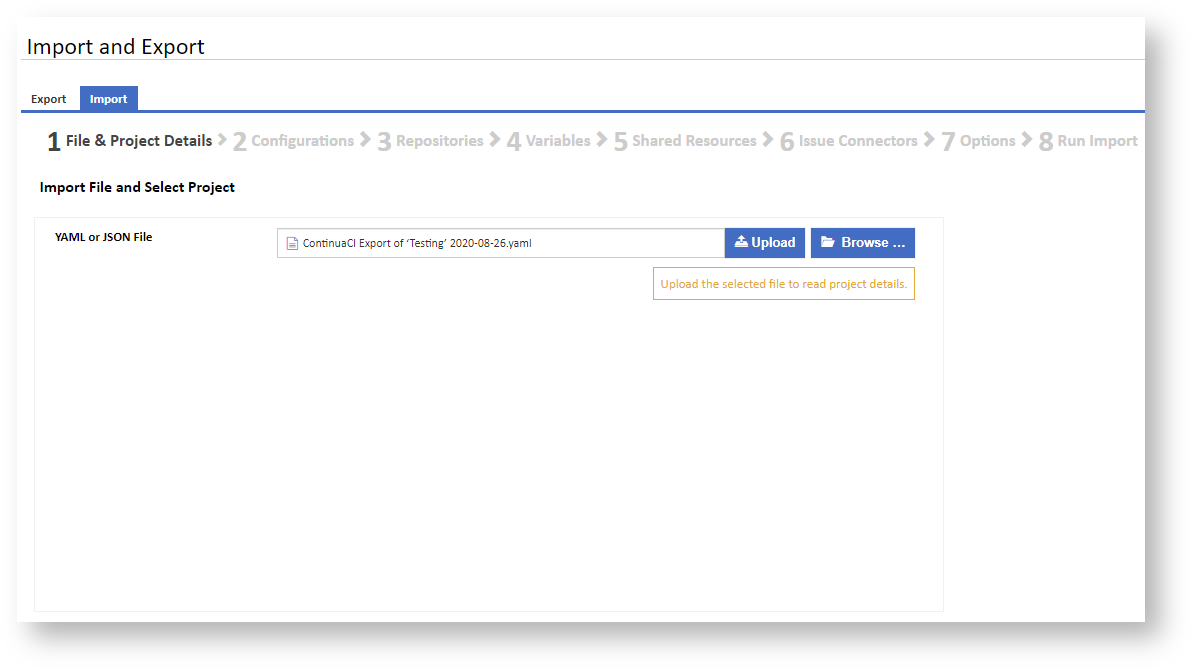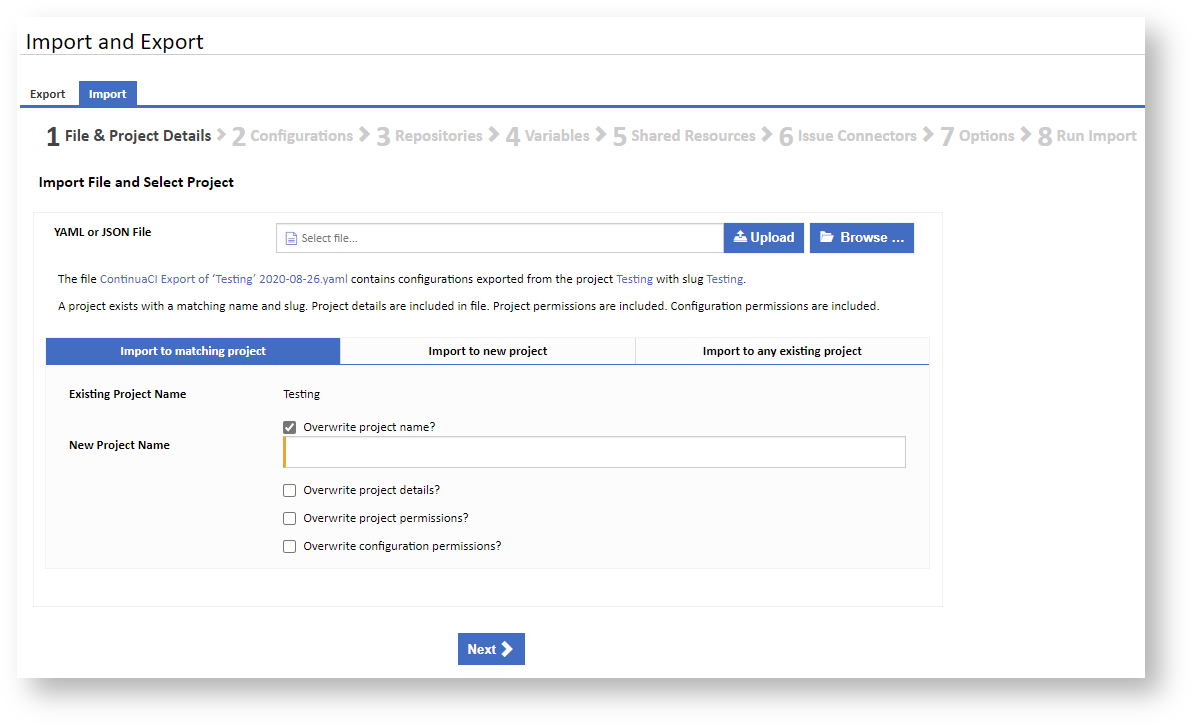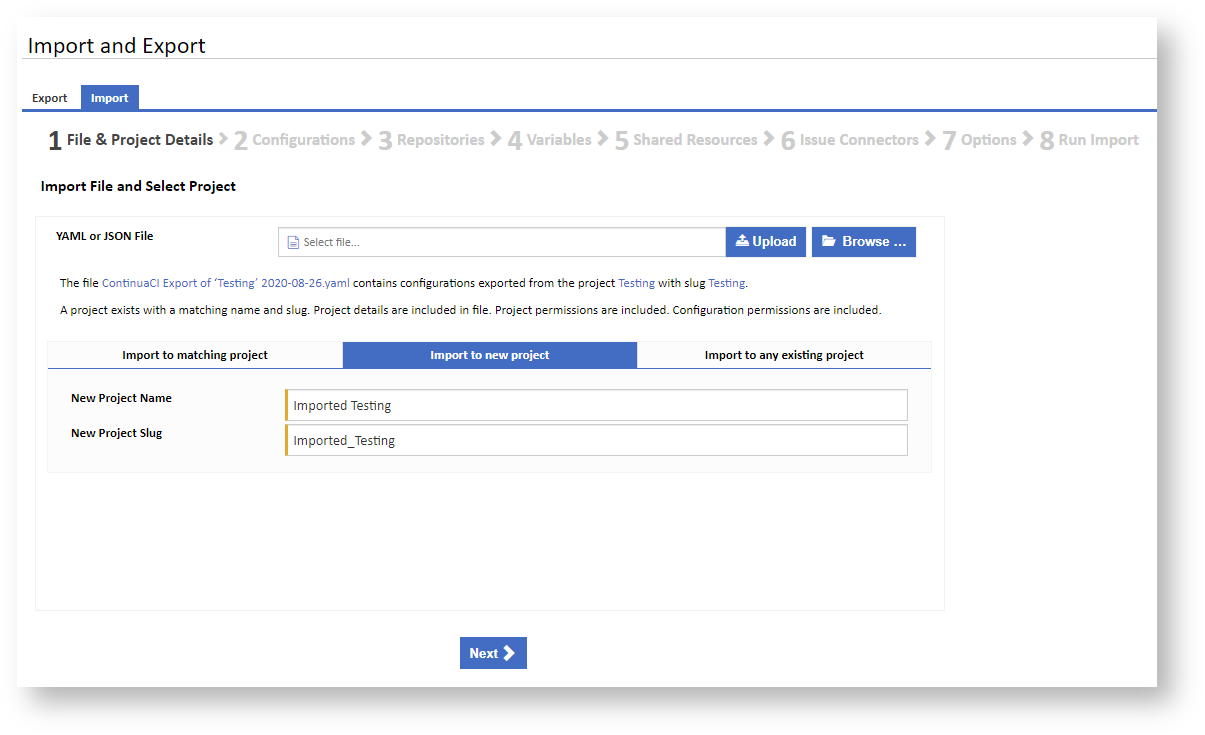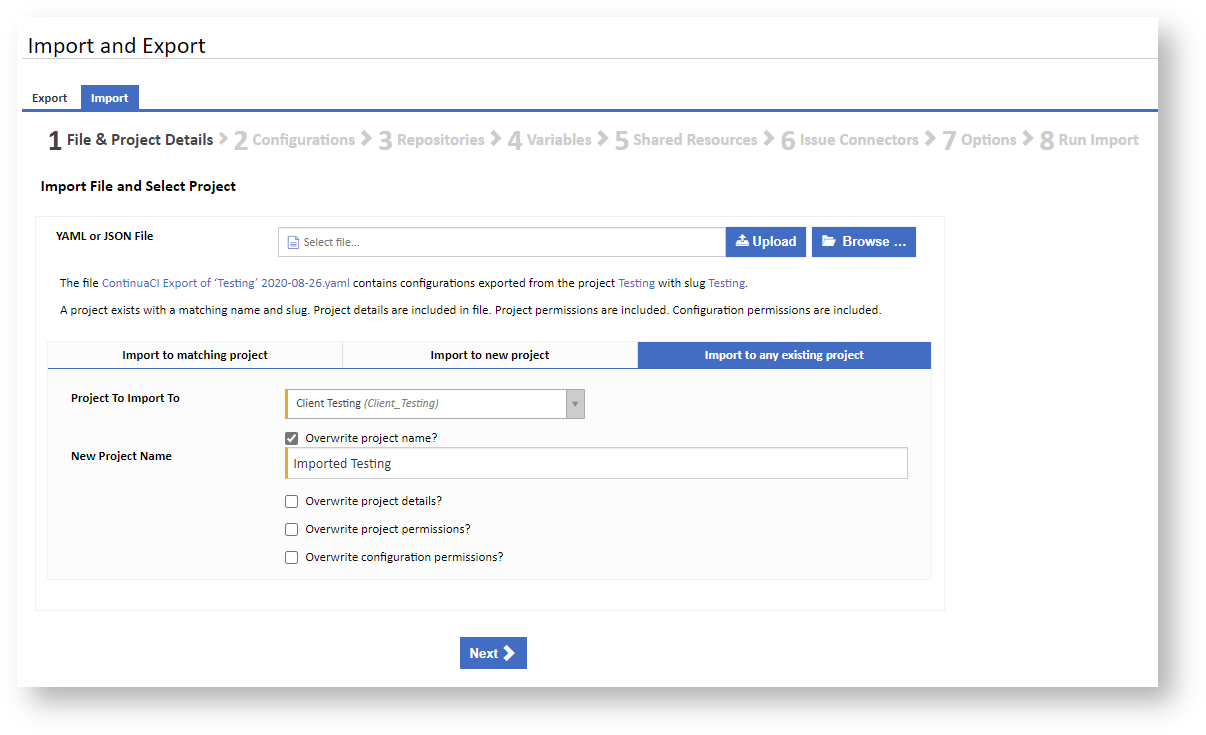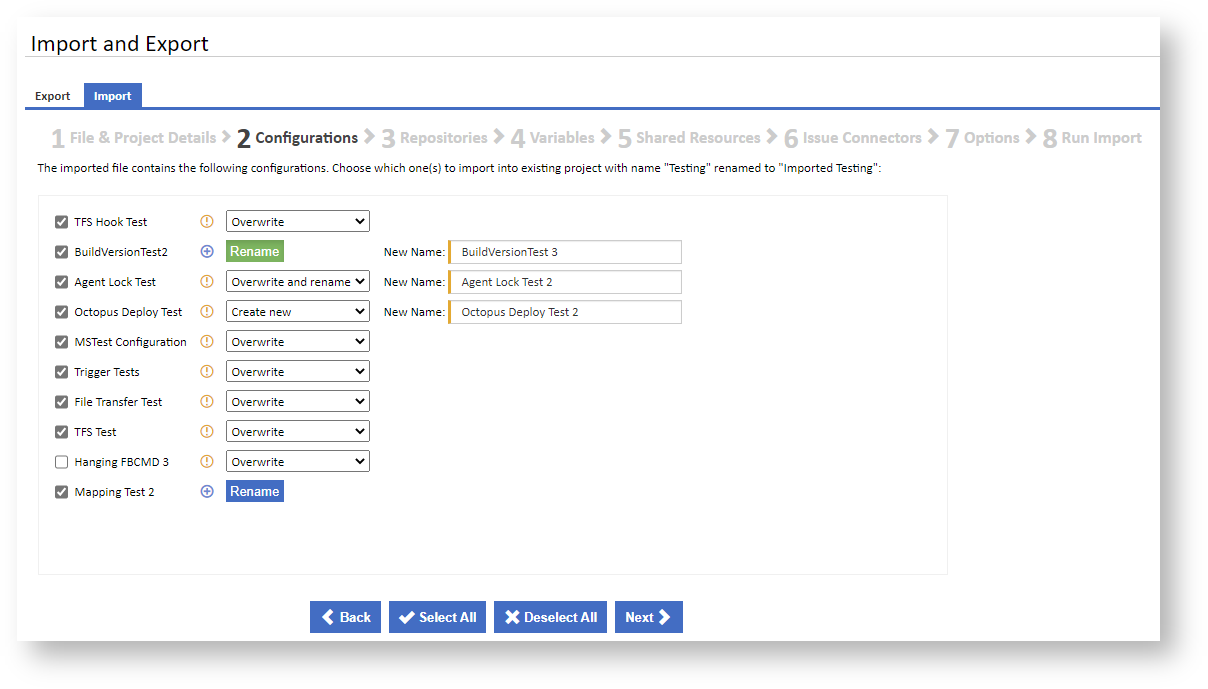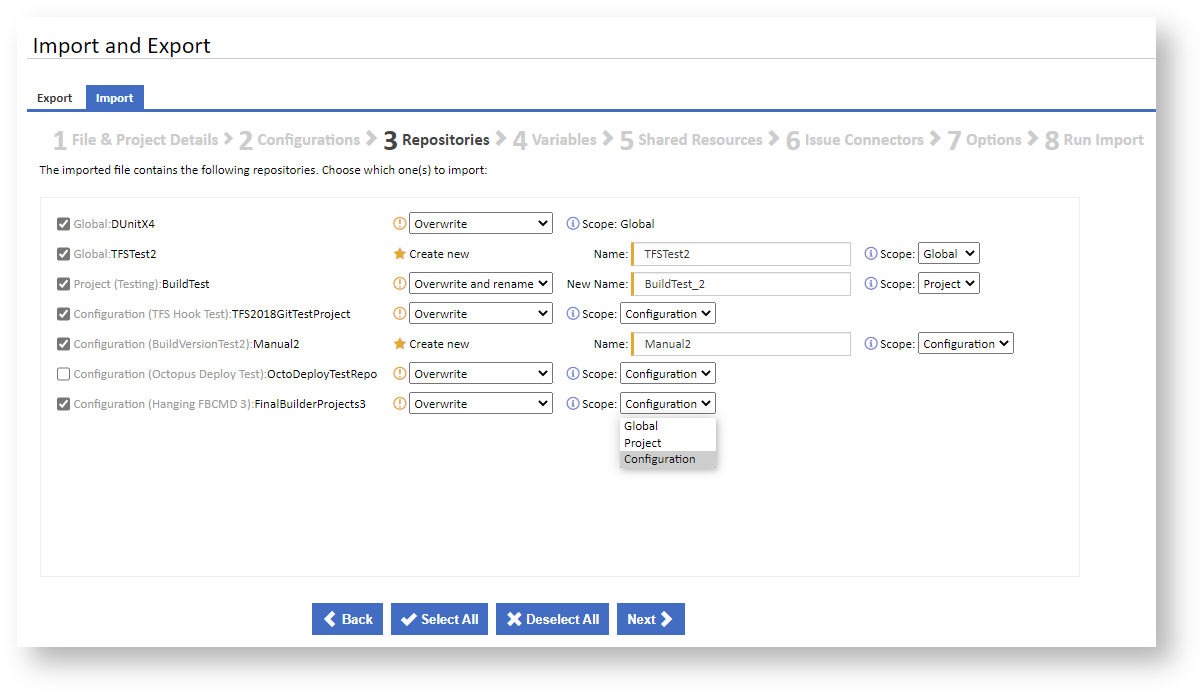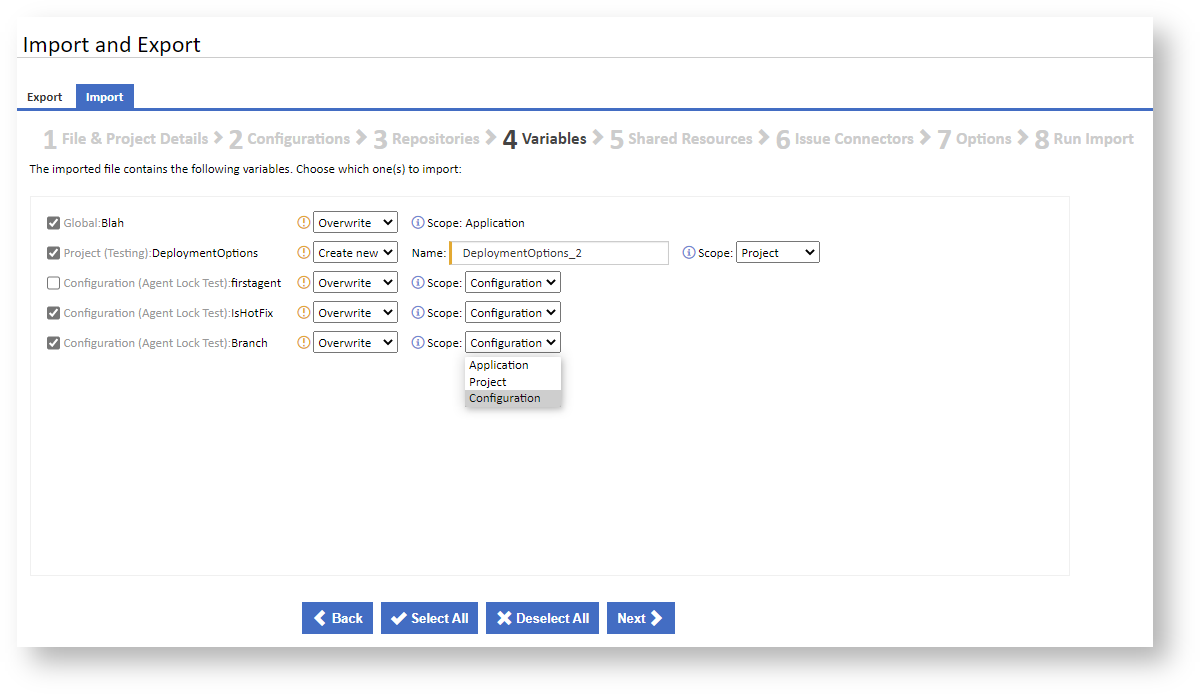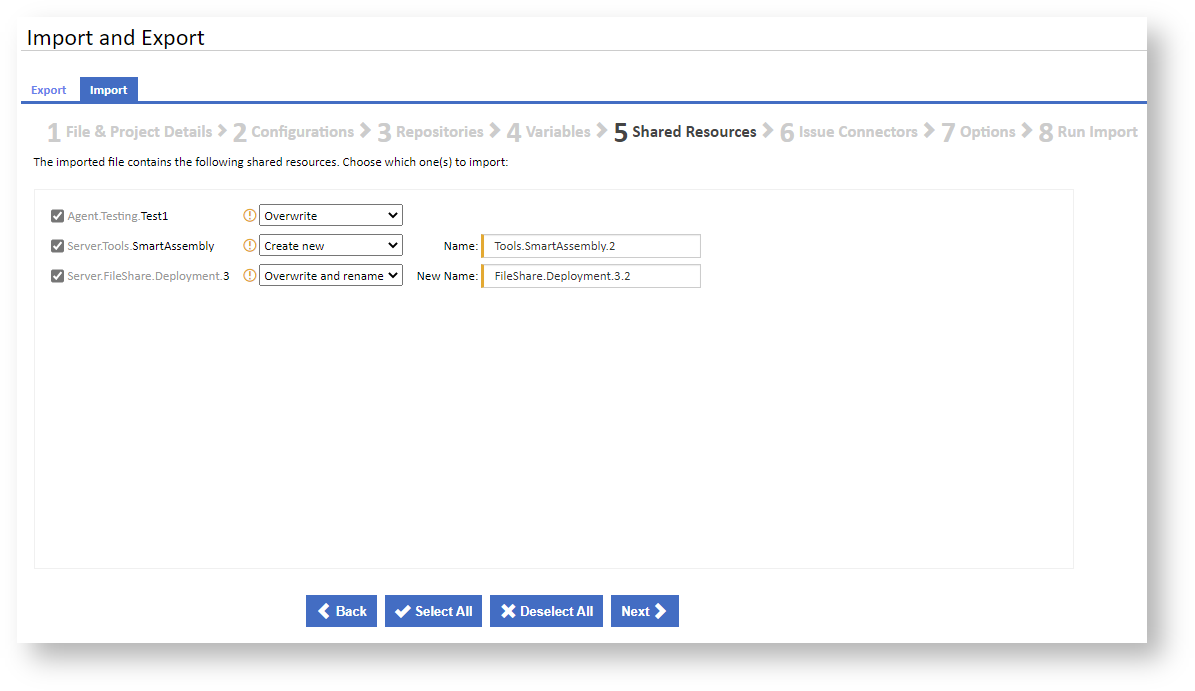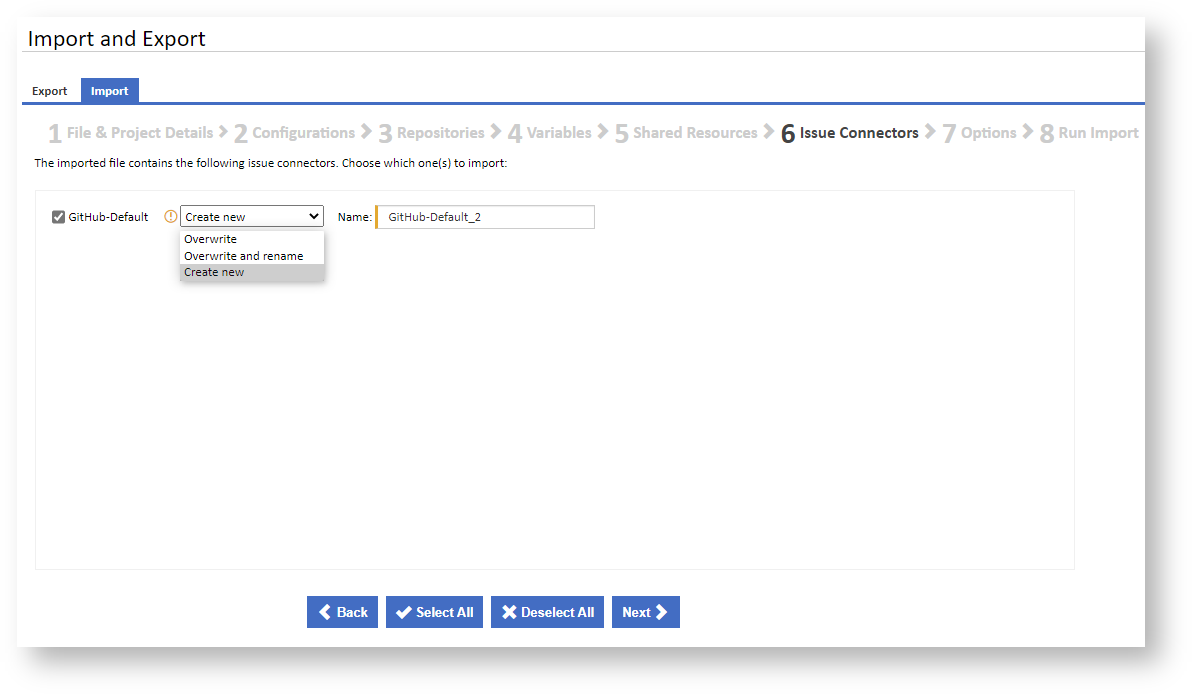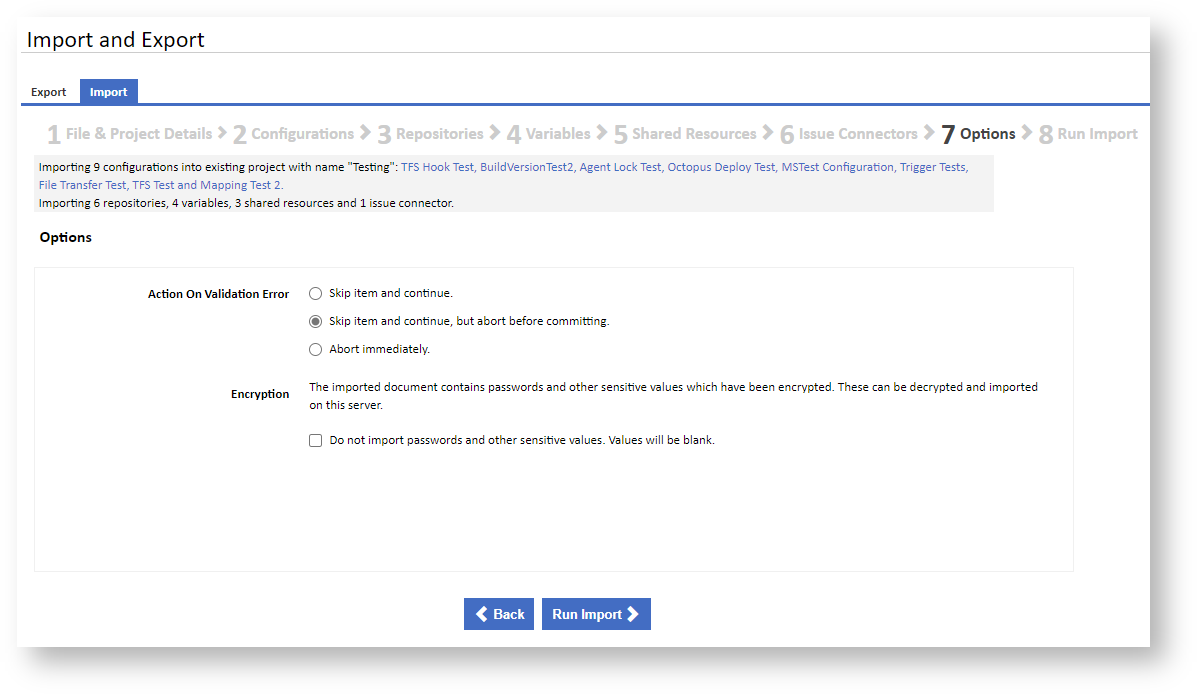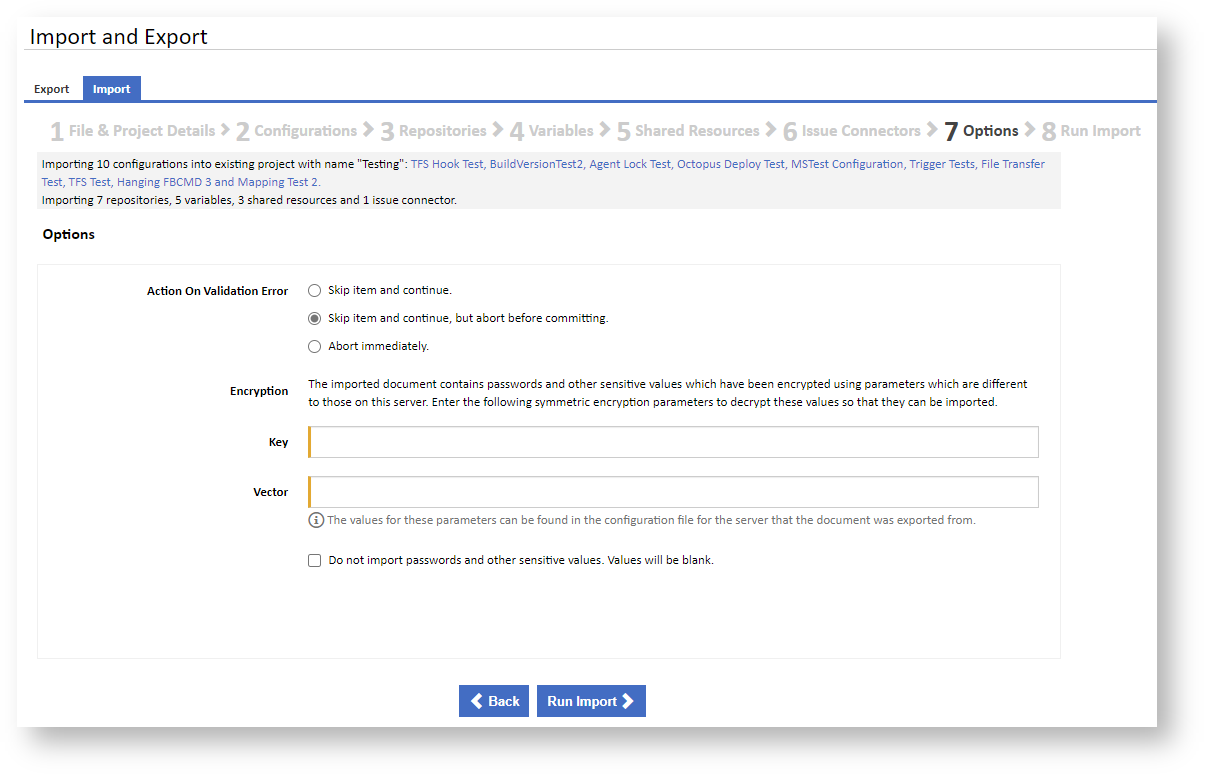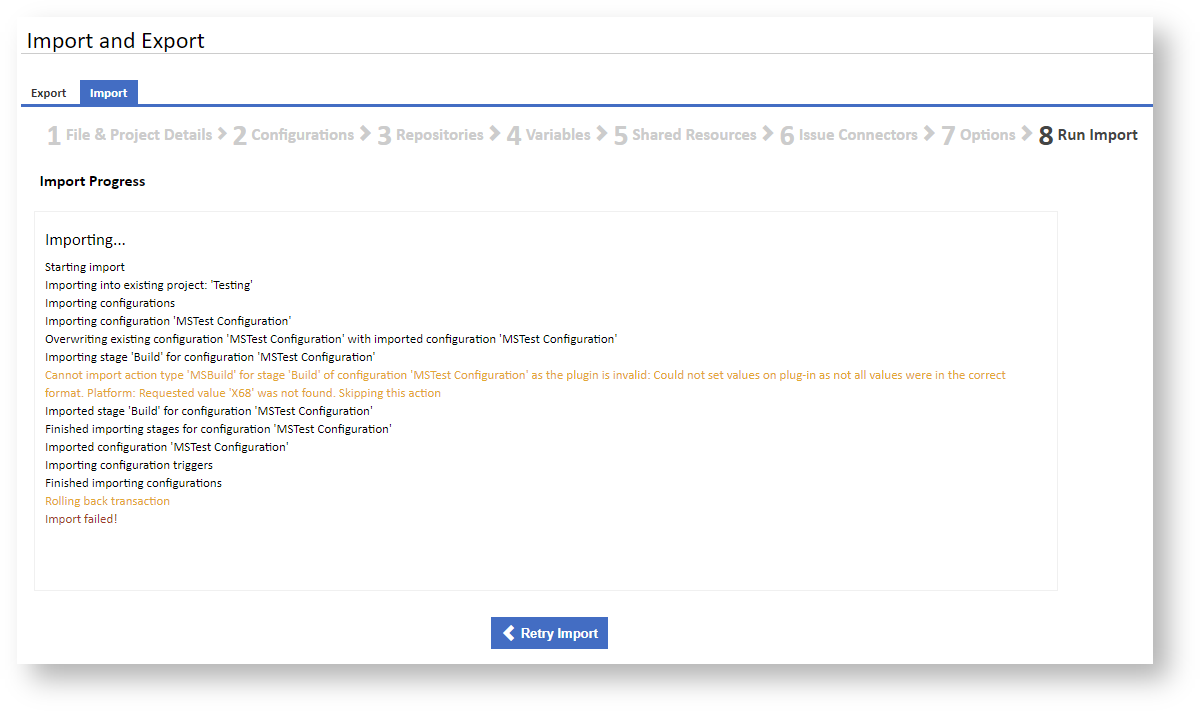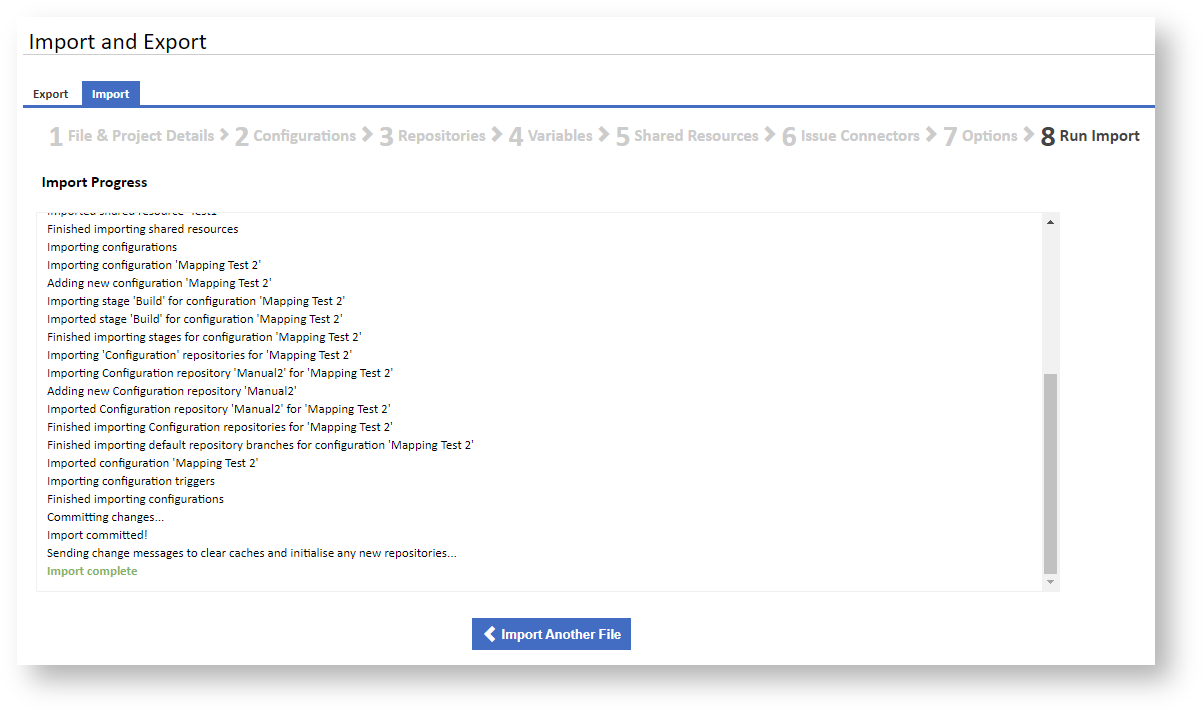Once you are on the Import and Export page in the Administration section, ensure that the Import tab is selected to start the Import Wizard. Click Browse to select a file to upload, then click the Upload button to send the file to the server for processing.
File & Project Details
The main details about the imported file will be displayed and you will be provided with options allowing you to either Import to a new project, Import to any existing project or, if matching project is found, Import to a matching project.
Import to a matching project
If a matching project is found on the server, you can choose to overwrite the project. You can optionally choose to Overwrite the project name and provide a New Project Name for the matching project. If project details exist in the imported file, then you can optionally Overwrite project details in the matching project. Likewise, if project permissions exist in the imported project, you can optionally Overwrite project permissions in the matching project. In later steps, you will also have the option to overwrite configurations in the matching project, if configuration permissions exist and you choose Overwrite configuration permissions here, then the permissions will be overwritten in all selected configurations.
Import to a new project
You can choose to import the project as a new project and give in a New Project Name and New Project Slug. All project details, permissions and configurations will be imported to this new project.
Import to any existing project
You can choose to select an existing project to overwrite. If project details exist in the imported file, then the existing project details will be replaced with these details. You can optionally choose to Overwrite the project name and provide a New Project Name for the existing project. In later steps, you will also have the option to overwrite configurations in the existing project.
You can choose to select an existing project to overwrite. You can optionally choose to Overwrite the project name and provide a New Project Name for the existing project. If project details exist in the imported file, then you can optionally Overwrite project details in the existing project. Likewise, if project permissions exist in the imported project, you can optionally Overwrite project permissions in the existing project. In later steps, you will also have the option to overwrite configurations in the existing project, if configuration permissions exist and you choose Overwrite configuration permissions here, then the permissions will be overwritten in all selected configurations.
Once you have chosen the relevant Project options, click Next to move to the Configurations step.
Configurations
The Configurations step of the Import wizard shows a list of all the configurations in the imported document. Check boxes are provided allowing you to choose which configurations to import.
If importing to a new or empty project, or if no match is found for a configuration, aicon is displayed, indicating the configuration is new. You can optionally give the new configuration a new name by clicking on the Rename button. A New Name text box is shown allowing you to enter the new name.
If importing to an existing project and a match is found for a configuration, aicon is displayed, indicating the configuration exists. You can choose to:
- Overwrite: The fields in the matching existing configuration will be overwritten with the fields in the imported configuration,
- Overwrite and rename: The fields in the matching existing configuration will be overwritten with the fields in the imported configuration, plus a New Name text box will be shown allowing you to enter a new name to apply to the matching existing configuration.
- Create new: A new configuration will be created and populated with the imported field values. A New Name text box is shown allowing you to enter a name for the new configuration.
Once you have chosen the required Configurations and related options, click Next to move to the Repositories step. Alternatively, click Back to return to the File & Project Details step.
Repositories
The Repositories step of the Import wizard shows a list of all the repositories in the imported document. Check boxes are provided allowing you to choose which repositories to import.
If an existing matching repository is not found aicon is displayed and, if the repository is selected, it will be created as a new repository. You can optionally edit the Name and change the Scope for the new repository to Global, Project or Configuration. Note that Configuration scope is only available if you are importing a single configuration.
If an existing matching repository is found aicon is displayed. You can choose to:
- Overwrite: The fields in the matching existing repository will be overwritten with the fields in the imported repository. With this option selected, the repository Scope can optionally be changed to a more general scope. e.g. Configuration to Project/Global, or Project to Global.
- Overwrite and rename: The fields in the matching existing repository will be overwritten with the fields in the imported repository, plus a New Name text box will be shown allowing you to enter a new name to apply to the matching existing repository. With this option selected, the repository Scope can optionally be changed to a more general scope. e.g. Configuration to Project/Global, or Project to Global.
- Create new: A new repository will be created and populated with the imported field values. A New Name text box is shown allowing you to enter a name for the new repository. You can also optionally change the Scope for the new repository to Global, Project or Configuration. Note that Configuration scope is only available if you are importing a single configuration.
Once you have chosen the required Repositories and related options, click Next to move to the Variables step. Alternatively, click Back to return to the Configurations step.
Variables
The Variables step of the Import wizard shows a list of all the variables in the imported document. Check boxes are provided allowing you to choose which variables to import.
If an existing matching variable is not found aicon is displayed and, if the variable is selected, it will be created as a new variable. You can optionally edit the Name and change the Scope for the new variable to Application, Project or Configuration. Note that Configuration scope is only available if you are importing a single configuration.
If an existing matching variable is found aicon is displayed. You can choose to:
- Overwrite: The fields in the matching existing variable will be overwritten with the fields in the imported variable. With this option selected, the variable Scope can optionally be changed to a more general scope. e.g. Configuration to Project/Application, or Project to Application.
- Overwrite and rename: The fields in the matching existing variable will be overwritten with the fields in the imported variable, plus a New Name text box will be shown allowing you to enter a new name to apply to the matching existing variable. With this option selected, the variable Scope can optionally be changed to a more general scope. e.g. Configuration to Project/Application, or Project to Application.
- Create new: A new variable will be created and populated with the imported field values. A New Name text box is shown allowing you to enter a name for the new variable. You can also optionally change the Scope for the new variable to Application, Project or Configuration. Note that Configuration scope is only available if you are importing a single configuration.
Once you have chosen the required Variables and related options, click Next to move to the Shared Resources step. Alternatively, click Back to return to the Repositories step.
Shared Resources
The Shared Resources step of the Import wizard shows a list of all the shared resources in the imported document. Check boxes are provided allowing you to choose which shared resources to import.
If an existing matching shared resource is not found aicon is displayed and, if the shared resource is selected, it will be created as a new shared resource. You can optionally edit the Name for the new shared resource.
If an existing matching shared resource is found aicon is displayed. You can choose to:
- Overwrite: The fields in the matching existing shared resource will be overwritten with the fields in the imported shared resource.
- Overwrite and rename: The fields in the matching existing shared resource will be overwritten with the fields in the imported shared resource, plus a New Name text box will be shown allowing you to enter a new name to apply to the matching existing shared resource.
- Create new: A new shared resource will be created and populated with the imported field values. A New Name text box is shown allowing you to enter a name for the new shared resource.
Once you have chosen the required Shared Resources and related options, click Next to move to the Issue Connectors step. Alternatively, click Back to return to the Variables step.
Issue Connectors
The Issue Connectors step of the Import wizard shows a list of all the issue connectors in the imported document. Check boxes are provided allowing you to choose which issue connectors to import.
If an existing matching issue connector is not found aicon is displayed and, if the issue connector is selected, it will be created as a new shared resource. You can optionally edit the Name for the new issue connector.
If an existing matching issue connector is found aicon is displayed. You can choose to:
- Overwrite: The fields in the matching existing issue connector will be overwritten with the fields in the imported issue connector.
- Overwrite and rename: The fields in the matching existing issue connector will be overwritten with the fields in the imported issue connector, plus a New Name text box will be shown allowing you to enter a new name to apply to the matching existing issue connector.
- Create new: A new issue connector will be created and populated with the imported field values. A New Name text box is shown allowing you to enter a name for the new issue connector.
Once you have chosen the required Issue Connectors and related options, click Next to move to the Options step. Alternatively, click Back to return to the Shared Resources step.
Options
This step of the Import wizard allows you to choose options related to the import process.
Action On Validation Error
If the imported file contains invalid content for any of the fields, then a validation error may occur and will be displayed in the import log. Here you can choose whether the import process should continue or abort.
Abort immediately: If a validation error occurs, the import process will be aborted, no items will be imported, no changes will be committed to the database.
Skip item and continue, but abort before committing: This is the default option. If it is possible to continue, then the invalid item will be skipped and a warning will be displayed in the import log. The import process will continue to import the next item. At the end of the import process, changes will not, however, be committed to the database. If there are multiple validation issues, then this option will allow you to see all of them at once.
Skip item and continue: If it is possible to continue, then the invalid item will be skipped and a warning will be displayed in the import log. The import process will continue to import the next item. At the end of the import process, changes will be committed to the database.
Encryption
If the imported file contains encrypted passwords and other sensitive values, then you can choose whether to import them.
If you are import a file exported on a different server, the encryption keys will be different. In this case, input boxes will be provided to allow you to enter the encryption parameters.
The encryption Key and Vector can be found in the appSettings section of server configuration file under the keys "Continua.SymmetricEncryptionKey" and "Continua.SymmetricEncryptionVector".
e.g.
<appSettings> <!-- DO NOT remove or change the keys BELOW --> <!-- They are set during the first installation, changing them will require you to re-enter all passwords fields --> <!-- We recommend that you keep a backup of these values --> <add key="Continua.HashSalt" value="**************"/> <add key="Continua.SymmetricEncryptionKey" value="**************" /> <add key="Continua.SymmetricEncryptionVector" value="**************" /> <!-- DO NOT remove these the keys ABOVE --> ..... </appSettings>
Once you have entered the required details, click Run Import to start the import process.
Run Import
While the import is running, progress messages are displayed.
If the import fails validation, a red Import failed! message and a Retry Import button is displayed. All changes are rolled back leaving the server database as it was before the import was started.
If the import is successful, a green Import complete message and an Import Another File button is displayed.
